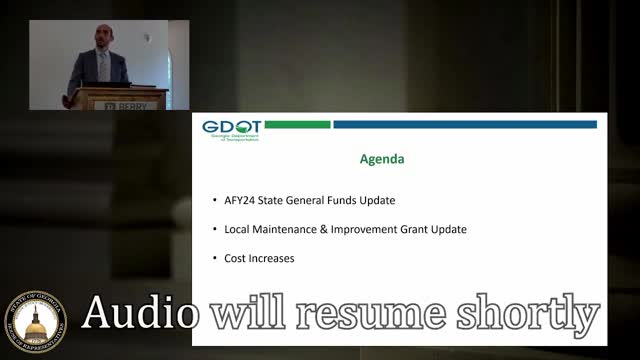Georgia Transportation Department Secures Major Funding Boost
August 30, 2024 | HOUSE OF REPRESENTATIVES, Committees, Legislative, Georgia
This article was created by AI summarizing key points discussed. AI makes mistakes, so for full details and context, please refer to the video of the full meeting. Please report any errors so we can fix them. Report an error »

In a recent government meeting, officials from the Georgia Department of Transportation (GDOT) highlighted significant funding developments and challenges facing the state's infrastructure projects. The amended fiscal year 2024 budget, bolstered by the signing of HB 915, has infused $1.5 billion into GDOT, marking a historic investment in transportation.
The funding is allocated across five key categories: $98 million for aviation projects, $250 million for local roads, $500 million for a new freight program, nearly $600 million for capital construction, and $50 million for capital maintenance. This financial boost is expected to expedite 42 projects statewide, advancing them by over 40 project years and initiating 19 new projects, particularly in freight infrastructure to support Georgia's economic growth.
Local governments have already received over 90% of the $250 million designated for local roads, with $223 million distributed to assist cities and counties in maintaining their roadway assets without requiring matching funds. This initiative aims to enhance local infrastructure significantly.
However, GDOT officials also expressed concerns regarding rising construction costs, which have surged dramatically over the past few years. The National Highway Construction Cost Index indicates that costs for materials such as asphalt, concrete, and steel have increased sharply, with some categories seeing price hikes of up to 160%. This inflationary pressure has reduced GDOT's purchasing power, complicating the delivery of infrastructure projects.
Officials emphasized the importance of maintaining a regular resurfacing schedule for roads, ideally every 15 years, to prevent costly structural damage. However, due to budget constraints and rising costs, the department has resurfaced only half the lane miles compared to three or four years ago, extending the time between necessary repairs.
As GDOT navigates these challenges, officials underscored the need for continued investment in infrastructure to support Georgia's growth and ensure the safety and reliability of its roadways. The meeting concluded with a call for further discussions on funding strategies to address resurfacing needs and maintain the state's transportation assets effectively.
The funding is allocated across five key categories: $98 million for aviation projects, $250 million for local roads, $500 million for a new freight program, nearly $600 million for capital construction, and $50 million for capital maintenance. This financial boost is expected to expedite 42 projects statewide, advancing them by over 40 project years and initiating 19 new projects, particularly in freight infrastructure to support Georgia's economic growth.
Local governments have already received over 90% of the $250 million designated for local roads, with $223 million distributed to assist cities and counties in maintaining their roadway assets without requiring matching funds. This initiative aims to enhance local infrastructure significantly.
However, GDOT officials also expressed concerns regarding rising construction costs, which have surged dramatically over the past few years. The National Highway Construction Cost Index indicates that costs for materials such as asphalt, concrete, and steel have increased sharply, with some categories seeing price hikes of up to 160%. This inflationary pressure has reduced GDOT's purchasing power, complicating the delivery of infrastructure projects.
Officials emphasized the importance of maintaining a regular resurfacing schedule for roads, ideally every 15 years, to prevent costly structural damage. However, due to budget constraints and rising costs, the department has resurfaced only half the lane miles compared to three or four years ago, extending the time between necessary repairs.
As GDOT navigates these challenges, officials underscored the need for continued investment in infrastructure to support Georgia's growth and ensure the safety and reliability of its roadways. The meeting concluded with a call for further discussions on funding strategies to address resurfacing needs and maintain the state's transportation assets effectively.
View full meeting
This article is based on a recent meeting—watch the full video and explore the complete transcript for deeper insights into the discussion.
View full meeting
